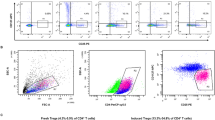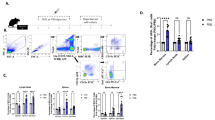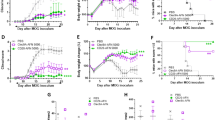Abstract
Although previous studies have described CD25 expression and production of interleukin-2 (IL-2) by mature dendritic cells (mDCs), it remains unclear how these molecules participate in the activation of T cells. In search of the mechanisms by which daclizumab, a humanized monoclonal antibody against CD25, inhibits brain inflammation in multiple sclerosis, we observed that although the drug has limited effects on polyclonal T cell activation, it potently inhibits activation of antigen-specific T cells by mDCs. We show that mDCs (and antigen-experienced T cells) secrete IL-2 toward the mDC-T cell interface in an antigen-specific manner, and mDCs 'lend' their CD25 to primed T cells in trans to facilitate early high-affinity IL-2 signaling, which is crucial for subsequent T cell expansion and development of antigen-specific effectors. Our data reveal a previously unknown mechanism for the IL-2 receptor system in DC-mediated activation of T cells.
This is a preview of subscription content, access via your institution
Access options
Subscribe to this journal
Receive 12 print issues and online access
$209.00 per year
only $17.42 per issue
Buy this article
- Purchase on Springer Link
- Instant access to full article PDF
Prices may be subject to local taxes which are calculated during checkout






Similar content being viewed by others
References
Waldmann, T.A. & O'Shea, J. The use of antibodies against the IL-2 receptor in transplantation. Curr. Opin. Immunol. 10, 507–512 (1998).
Nussenblatt, R.B. et al. Treatment of noninfectious intermediate and posterior uveitis with the humanized anti-Tac mAb: a phase I/II clinical trial. Proc. Natl. Acad. Sci. USA 96, 7462–7466 (1999).
Bielekova, B. et al. Humanized anti-CD25 (daclizumab) inhibits disease activity in multiple sclerosis patients failing to respond to interferon-β. Proc. Natl. Acad. Sci. USA 101, 8705–8708 (2004).
Bielekova, B. et al. Effect of anti-CD25 antibody daclizumab in the inhibition of inflammation and stabilization of disease progression in multiple sclerosis. Arch. Neurol. 66, 483–489 (2009).
Rose, J.W. et al. Daclizumab phase II trial in relapsing and remitting multiple sclerosis: MRI and clinical results. Neurology 69, 785–789 (2007).
Willerford, D.M. et al. Interleukin-2 receptor α chain regulates the size and content of the peripheral lymphoid compartment. Immunity 3, 521–530 (1995).
Sharfe, N., Dadi, H.K., Shahar, M. & Roifman, C.M. Human immune disorder arising from mutation of the α chain of the interleukin-2 receptor. Proc. Natl. Acad. Sci. USA 94, 3168–3171 (1997).
Aoki, C.A. et al. IL-2 receptor α deficiency and features of primary biliary cirrhosis. J. Autoimmun. 27, 50–53 (2006).
Roifman, C.M. Human IL-2 receptor α chain deficiency. Pediatr. Res. 48, 6–11 (2000).
Morgan, D.A., Ruscetti, F.W. & Gallo, R. Selective in vitro growth of T lymphocytes from normal human bone marrows. Science 193, 1007–1008 (1976).
Setoguchi, R., Hori, S., Takahashi, T. & Sakaguchi, S. Homeostatic maintenance of natural Foxp3+ CD25+ CD4+ regulatory T cells by interleukin (IL)-2 and induction of autoimmune disease by IL-2 neutralization. J. Exp. Med. 201, 723–735 (2005).
Lenardo, M.J. Interleukin-2 programs mouse T lymphocytes for apoptosis. Nature 353, 858–861 (1991).
Martin, J.F., Perry, J.S., Jakhete, N.R., Wang, X. & Bielekova, B. An IL-2 paradox: blocking CD25 on T cells induces IL-2–driven activation of CD56(bright) NK cells. J. Immunol. 185, 1311–1320 (2010).
Oh, U. et al. Regulatory T cells are reduced during anti-CD25 antibody treatment of multiple sclerosis. Arch. Neurol. 66, 471–479 (2009).
Bielekova, B. et al. Regulatory CD56(bright) natural killer cells mediate immunomodulatory effects of IL-2R-α–targeted therapy (daclizumab) in multiple sclerosis. Proc. Natl. Acad. Sci. USA 103, 5941–5946 (2006).
Wang, X., Rickert, M. & Garcia, K.C. Structure of the quaternary complex of interleukin-2 with its α, β and γc receptors. Science 310, 1159–1163 (2005).
Leonard, W.J. et al. Signaling via the IL-2 and IL-7 receptors from the membrane to the nucleus. Cold Spring Harb. Symp. Quant. Biol. 64, 417–424 (1999).
Malek, T.R. The biology of interleukin-2. Annu. Rev. Immunol. 26, 453–479 (2008).
Granucci, F., Zanoni, I., Feau, S. & Ricciardi-Castagnoli, P. Dendritic cell regulation of immune responses: a new role for interleukin 2 at the intersection of innate and adaptive immunity. EMBO J. 22, 2546–2551 (2003).
Granucci, F. et al. Inducible IL-2 production by dendritic cells revealed by global gene expression analysis. Nat. Immunol. 2, 882–888 (2001).
Velten, F.W., Rambow, F., Metharom, P. & Goerdt, S. Enhanced T-cell activation and T-cell–dependent IL-2 production by CD83+, CD25high, CD43high human monocyte-derived dendritic cells. Mol. Immunol. 44, 1544–1550 (2007).
Mnasria, K., Lagaraine, C., Manaa, J., Lebranchu, Y. & Oueslati, R. Anti CD25 treatment of human dendritic cells modulates both their cytokine synthesis profiles and their capacity to activate allogeneic CD4 T cells: a potential tolerogenic effect. Int. Immunopharmacol. 8, 414–422 (2008).
Mnasria, K., Lagaraine, C., Velge-Roussel, F., Lebranchu, Y. & Baron, C. Anti-CD25 antibodies decrease the ability of human dendritic cells to prime allogeneic CD4 T cells. Transplant. Proc. 41, 695–697 (2009).
Mnasria, K. et al. Anti-CD25 antibodies affect cytokine synthesis pattern of human dendritic cells and decrease their ability to prime allogeneic CD4+ T cells. J. Leukoc. Biol. 84, 460–467 (2008).
Siragam, V. et al. Intravenous immunoglobulin ameliorates ITP via activating Fcγ receptors on dendritic cells. Nat. Med. 12, 688–692 (2006).
Dubois, S., Mariner, J., Waldmann, T.A. & Tagaya, Y. IL-15Rα recycles and presents IL-15 in trans to neighboring cells. Immunity 17, 537–547 (2002).
Bielekova, B. et al. Encephalitogenic potential of the myelin basic protein peptide (amino acids 83–99) in multiple sclerosis: results of a phase II clinical trial with an altered peptide ligand. Nat. Med. 6, 1167–1175 (2000).
Slack, E.C. et al. Syk-dependent ERK activation regulates IL-2 and IL-10 production by DC stimulated with zymosan. Eur. J. Immunol. 37, 1600–1612 (2007).
Strowig, T. et al. Tonsilar NK cells restrict B cell transformation by the Epstein-Barr virus via IFN-γ. PLoS Pathog. 4, e27 (2008).
Kronin, V., Vremec, D. & Shortman, K. Does the IL-2 receptor α chain induced on dendritic cells have a biological function? Int. Immunol. 10, 237–240 (1998).
Létourneau, S., Krieg, C., Pantaleo, G. & Boyman, O. IL-2- and CD25-dependent immunoregulatory mechanisms in the homeostasis of T-cell subsets. J. Allergy Clin. Immunol. 123, 758–762 (2009).
Caudy, A.A., Reddy, S.T., Chatila, T., Atkinson, J.P. & Verbsky, J.W. CD25 deficiency causes an immune dysregulation, polyendocrinopathy, enteropathy, X-linked–like syndrome and defective IL-10 expression from CD4 lymphocytes. J. Allergy Clin. Immunol. 119, 482–487 (2007).
Wynn, D. et al. Daclizumab in active relapsing multiple sclerosis (CHOICE study): a phase 2, randomised, double-blind, placebo-controlled, add-on trial with interferon β. Lancet Neurol. 9, 381–390 (2010).
Cartagena, C.M., Burns, M.P. & Rebeck, G.W. 24S-hydroxycholesterol effects on lipid metabolism genes are modeled in traumatic brain injury. Brain Res. 1319, 1–12 (2010).
Acknowledgements
The study was supported by the intramural research program of the NINDS/NIH. We thank A. Kashani for expert technical assistance in processing apheresis samples and M. Lenardo, W. Leonard and H. McFarland for their critical review of the manuscript and helpful comments. Additionally, we are thankful to M. Lenardo and H. Su (NIH) for providing cryopreserved peripheral blood mononuclear cells (PBMCs) from the CD25− individual. Daclizumab Fab was provided by Abbott Biotherapeutics, under Material Transfer Agreement.
Author information
Authors and Affiliations
Contributions
B.B. developed the concept of the study and supervised the project. B.B. and T.A.W. designed the experiments. S.C.W., J.F.M., S.H., J.S.A.P., C.M.C., D.M., J.E., E.M. and B.B. performed the experiments and analyzed the data. B.B., S.C.W., J.F.M., S.H. and C.M.C. wrote the paper. All authors approved the final version of this paper.
Ethics declarations
Competing interests
B.B. and T.A.W. are co-inventors on US National Institutes of Health patents related to the use of daclizumab in multiple sclerosis and as such have received patent royalty payments.
Supplementary information
Supplementary Text and Figures
Supplementary Figures 1–8 (PDF 709 kb)
Rights and permissions
About this article
Cite this article
Wuest, S., Edwan, J., Martin, J. et al. A role for interleukin-2 trans-presentation in dendritic cell–mediated T cell activation in humans, as revealed by daclizumab therapy. Nat Med 17, 604–609 (2011). https://doi.org/10.1038/nm.2365
Received:
Accepted:
Published:
Issue Date:
DOI: https://doi.org/10.1038/nm.2365
This article is cited by
-
Immunostimulatory gene therapy targeting CD40, 4-1BB and IL-2R activates DCs and stimulates antigen-specific T-cell and NK-cell responses in melanoma models
Journal of Translational Medicine (2023)
-
Strategies to therapeutically modulate cytokine action
Nature Reviews Drug Discovery (2023)
-
Impact of disease-modifying therapy on dendritic cells and exploring their immunotherapeutic potential in multiple sclerosis
Journal of Neuroinflammation (2022)
-
Contact-dependent delivery of IL-2 by dendritic cells to CD4 T cells in the contraction phase promotes their long-term survival
Protein & Cell (2020)
-
Central CD4+ T cell tolerance: deletion versus regulatory T cell differentiation
Nature Reviews Immunology (2019)



